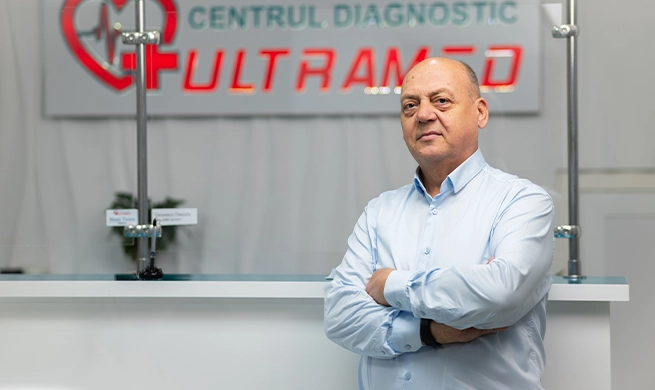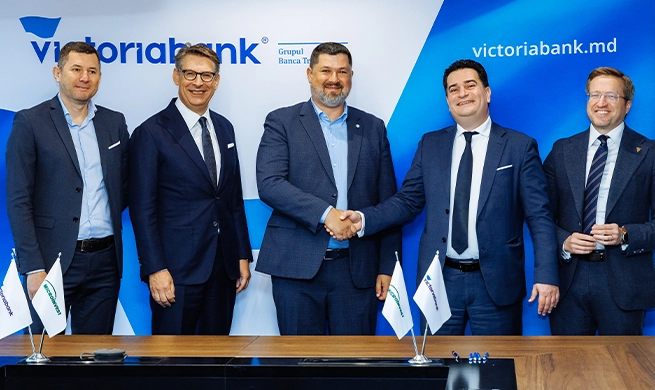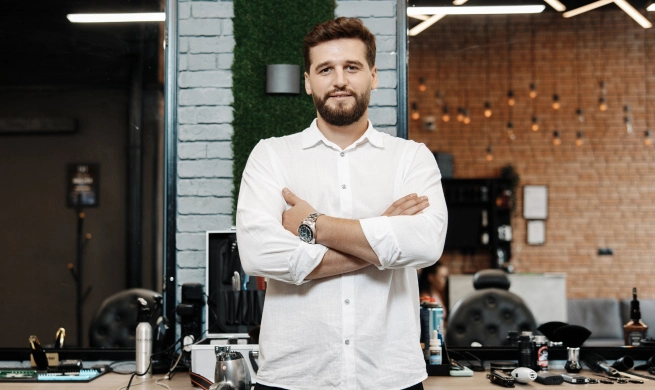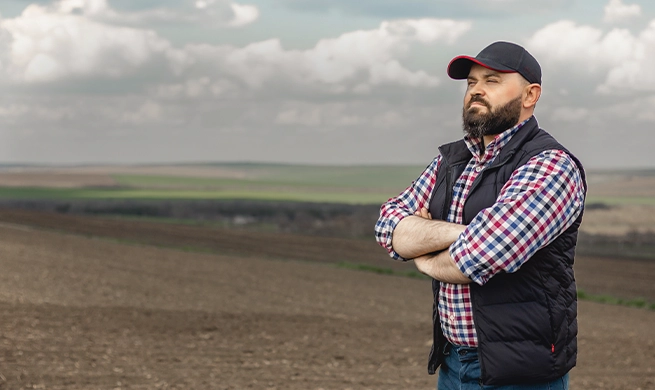Interview conducted by Pavel Zingan with Dmitrii Svinarenco, CEO of Microinvest
Dmitrii, good afternoon. Before our meeting, I reviewed the interview we did at the very beginning of the pandemic. I noticed that this summer marks a “personal” anniversary for you at Microinvest – 10 years leading the company. Am I right?
Yes. In 2015, I joined Microinvest with a small but united and highly professional team. And over these 10 years, we have achieved even more than we once dreamed of.
You’re being modest. Looking at Moldova’s financial market statistics, Microinvest now ranks fifth, right after the country’s four largest banks, ahead of several other banks. And yet, Microinvest is not a bank – It doesn’t conduct settlement operations for clients, doesn’t take deposits, it only issues loans. To illustrate, I’d compare this to a lightweight boxer entering a heavier weight category and winning, all while fighting with one hand tied behind his back.
It’s a flattering comparison, but not exactly accurate in describing our relationship with Moldova’s banking sector. Of course, we compete with banks in the lending market, but at the same time, we are also one of their clients, bringing them significant income. That said, you’re right – Microinvest’s results can indeed be called extraordinary. We often grew by more than 40% per year. When my team and I joined in 2015, Microinvest’s loan portfolio was 245 million lei. Today, it is 6.7 billion lei.
Let me grab a calculator… That’s 27 times growth! I don’t know how you pulled that off, but it’s truly phenomenal – especially considering the market was already saturated with microfinance organizations offering loans. If I remember correctly, there were over a hundred of them.
140 – 160, at least.
Then you could probably write an entire book on the secrets of growing a financial organization during economically challenging periods. Since 2015, I can’t recall a single “cloudless” year – not to mention the pandemic years or the year the war in Ukraine began. And now there’s another reason to look back and evaluate the past decade. Can we talk about the deal Microinvest is currently preparing for?
You mean the negotiations between our shareholders and the BT Group on acquiring Microinvest? Yes, that’s no secret. We’ve actually been here before – in 2019, we signed a letter of intent with BT Group for the same purpose, but the global pandemic changed everything, and the deal didn’t go through. This time, BT Group is represented by Victoriabank. The letter of intent has been signed again, and we, as one of the parties, are now working on its implementation.
I’ll ask the layman’s question here – I haven’t been following the details closely. Am I correct in understanding that Victoriabank is buying your loan portfolio?
No, it’s not about our clients’ loans being transferred to Victoriabank. We will continue to operate as a financial organization – only the shareholder structure will change. Victoriabank will take the place of the current shareholder group.
So, ready to sum up the decade? And I’d like to bust a stereotype with your help. There was a time when microfinance organizations had a poor reputation – accused of charging exorbitant interest rates and exploiting people’s financial illiteracy and hardships. But today, competition in the financial market is fierce, big banks are actively fighting to attract clients, and yet you continue to grow your loan portfolio. That means clients are deliberately choosing Microinvest as a partner, right?
You’ve touched on several topics at once. Let’s go one by one.
If we talk about Moldova’s non-banking lending market, there truly was a period when not-so-ethical financial engineering was flourishing. Clients were granted loans far beyond their repayment capacity, pushing them into debt with extremely high interest rates and penalties. I’m glad that this period is nearly behind us. I should note that Microinvest has never used, nor even considered such models. We developed our own path.
Our key difference from most financial organizations, including banks, is that we attract funding from abroad – primarily to lend to Moldovan businesses. We consistently work with over 15 foreign lenders, including government agencies and specialized development funds. These are borrowed funds, for which we pay interest. And since we mainly issue loans in MDL, the foreign currency we raise is placed on deposits in Moldovan banks, while the MDL for lending we obtain from those same banks. Through our 17 branches across the country, we have issued and continue to issue loans aimed not merely at covering financial gaps but at fostering economic development and growth.
For example, in agricultural lending, only one bank in Moldova has a larger portfolio than we do. But in terms of the number of loans issued to the agricultural sector, we are number one, ahead of all banks in the country.
If our lending foundation used to be microbusinesses, today we are successfully building strong portfolios in the mid-sized enterprise segment as well, where clients take loans up to 10 million MDL.
Let me interrupt for a stat – how many borrowers does Microinvest have today?
About 4,000 legal entities and 38,000 retail lending clients.
Impressive. Let’s continue on what set Microinvest apart from the majority of market players…
I’ve explained how we form our lending resources. Any professional understands that, on one hand, we have significant funds to lend, but on the other, these funds cost us much more than what Moldovan banks attract. This means we need unique advantages and value propositions to compete successfully.
So, what’s the difference?
We can call our approach by the English term “tailor-made” – delivering personalized solutions for the client’s unique needs.
That explains why clients are willing to pay a little more for your services. You know what it reminds me of? I haven’t bought trousers, suits, or coats off the rack for about twenty years – I’ve had them tailored by the same tailor. Yes, it’s more expensive than a store, but it’s worth it for how perfectly they fit and, most importantly, how comfortable they feel, as they’re made just for me.
That’s a good comparison. We became attractive to clients through our work approach and lending terms. Without exaggeration, I can say that unsecured lending, which is now widely offered even by leading banks, was our innovation for the Moldovan market many years ago. And it’s not about issuing a loan just for the sake of issuing it – within the company, we have robust and clear regulations for assessing lending risks. But our approach gave clients two major advantages that drew them to Microinvest: speed and flexibility.
We didn’t make clients waste time on what’s called transaction costs. We were always ready to come to them, understand their situation, advise, and help gather the necessary data and documents.
So, your main advantage is your attitude toward clients?
Yes, but notably, that attitude is only possible through building a unique corporate culture. That’s something I want to emphasize in this interview. When I joined the company, there was an individualistic mindset. Employees in key positions were focused on hitting performance metrics within a bonus-based pay system. We took an unconventional step – and ultimately abolished the bonus system, even for the front line. Today, Microinvest is not just a group of colleagues narrowly focused on short-term KPIs, but a team of like-minded people working toward a shared long-term result.
Another key element of our culture is the ability to make decisions in the best interest of the company, rather than in the interest of one’s individual role or small team. To give a personal example: when I became CEO, all management powers were concentrated in that position. This made the company dependent on one leader – good for him, but not for the company. I radically changed this principle. Now, management is in the hands of a five-person team, which makes leadership more resilient, reduces dependence on any one person, and produces more balanced decisions. In practice, this allowed the management team to redistribute roles and maintain steady growth even during one member’s maternity leave.
You talk a lot about people and the team. I’m also a believer in the “human touch” in any business, even the most high-tech. But let’s talk numbers now. Banks are investing huge amounts in digitalizing their operations. Don’t organizations like Microinvest risk falling behind in this digital race?
Business, without exaggeration, is often like an iceberg – the part underwater is much larger than what’s visible. Microinvest has its own IT subsidiary with over 40 employees, and its only client is Microinvest itself. Since 2023, our IT company has been a resident of the IT Park.
Initially, its main task was to meet our internal needs for automating business processes. Now, we are developing IT solutions for clients as well – from a web portal and client cabinet to a mobile app. For example, last year we launched a full cycle of digital retail lending, including onboarding, remote contract signing, and loan disbursement.
That said, no matter how our digitalization processes evolve, we will continue to maintain the personal level of client contact that has become our competitive advantage.
We’ve now, unintentionally, taken a retrospective look at Microinvest’s last ten years. You’re on the threshold of major changes. What would you like to wish the Microinvest team for the future?
We have an intangible asset that, in my view, has been the key driver behind the growth of our tangible assets. That is our unique corporate culture. I wish for it to be preserved — along with the team spirit – in the years to come.






